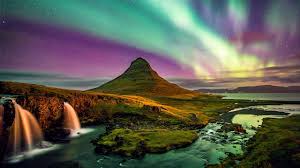The Northern Lights, also known as the Aurora Borealis, are among the most mesmerizing natural wonders on Earth. This phenomenon transforms the night sky into a vivid canvas of green, purple, red, and blue, dancing above the Arctic regions and captivating all who witness it. In this 1000-word article, we explore what causes the Northern Lights, the best places and times to see them, their cultural significance, and tips for planning your aurora adventure.
What Are the Northern Lights?
The Northern Lights are a natural light display that occurs predominantly in high-latitude regions around the Arctic. These interactions primarily occur in the thermosphere, around 80 to 300 kilometers above Earth.
When the solar wind reaches Earth, it interacts with our planet’s magnetic field, directing energy toward the magnetic poles. When these energetic particles collide with oxygen and nitrogen molecules in the atmosphere, the gases emit light, creating the luminous glow we recognize as auroras.
- Green is the most common color and is caused by oxygen molecules at lower altitudes.
- Red comes from oxygen at higher altitudes.
- Blue and purple hues are produced by nitrogen.
Where to See the Northern Lights
To witness the Northern Lights in their full glory, you must venture to high-latitude areas where the aurora activity is strongest. This area, known as the Auroral Oval, includes regions near the magnetic North Pole.
Top Locations to See the Aurora Borealis:
- Tromsø, Norway
- Located well above the Arctic Circle, Tromsø offers consistent aurora activity, stunning fjords, and easy access to guided tours.
- Fairbanks, Alaska, USA
- Clear skies and long nights make Fairbanks one of the best spots in North America to see the lights, especially between August and April.
- Yellowknife, Canada
- Known for its dark skies and minimal light pollution, Yellowknife provides a nearly 90% chance of viewing the lights during peak season.
- Reykjavík, Iceland
- Iceland’s unique volcanic landscape, combined with the auroras, offers a one-of-a-kind experience. Venture outside the city to avoid light pollution.
- Finnish Lapland
- Visit remote cabins and glass igloos in places like Rovaniemi or Kakslauttanen for a luxurious and immersive aurora experience.
When to See the Northern Lights
Timing is crucial when planning a trip to see the Northern Lights. The phenomenon is most active during winter months when nights are long and skies are dark.
- Best Months: Late September to early April.
Solar activity also influences auroras. Solar maximum (the peak of the sun’s 11-year cycle) increases the chances of stronger, more vivid displays. The next predicted solar maximum is around 2025, making the next couple of years a prime time to go aurora hunting.
The Cultural Significance of the Northern Lights
For centuries, the Northern Lights have inspired myths, legends, and scientific curiosity. Indigenous communities and ancient civilizations viewed them with reverence, fear, or awe.
- Inuit Legends suggest the lights were spirits playing ball with a walrus skull.
- Vikings saw them as reflections from Valkyrie armor guiding warriors to Valhalla.
Northern Lights Tourism: Growing Global Trend
Thanks to social media and better travel infrastructure, aurora tourism has surged in popularity. People from around the world travel thousands of miles to witness this spectacle.
Activities often include:
- Guided aurora hunts via snowmobile, dog sled, or minibus.
- Stays in glass-domed igloos or heated tents with transparent ceilings.
- Photography workshops and astrophotography experiences.
- Cultural experiences with local indigenous communities.
Tourism boards in Norway, Finland, and Iceland now offer aurora forecasts, mobile apps, and real-time alerts to enhance your chances of witnessing the display.
Tips for Seeing and Photographing the Northern Lights
- Check Aurora Forecasts
- Websites like NOAA’s Space Weather Prediction Center or apps like “My Aurora Forecast” provide KP index ratings (a scale of aurora activity from 0 to 9). A rating of 4 or higher increases your chances.
- Bring the Right Gear
- Wear layered, thermal clothing.
- Use a tripod for long-exposure photography.
- Choose a camera with manual settings to adjust shutter speed and ISO.
- Avoid Light Pollution
- . Remote areas or national parks are ideal.
- Stay Multiple Nights
- The Northern Lights are unpredictable. A multi-day trip improves your odds of catching a display.
Environmental Considerations
As aurora tourism grows, so does the environmental impact. Many remote arctic regions are fragile ecosystems. It’s important to travel responsibly:
- Support eco-friendly accommodations.
- Respect indigenous cultures and local guidelines.
- Minimize waste and carbon emissions during travel.
Conclusion: A Bucket List Experience
The Northern Lights offer a once-in-a-lifetime experience that blends science, beauty, and magic. Whether you’re a seasoned traveler or planning your first Arctic adventure, witnessing the aurora is a humbling reminder of our planet’s natural wonders. From the frozen tundras of Alaska to the remote wilderness of Lapland, the Northern Lights await anyone willing to brave the cold and look up into the night sky.



